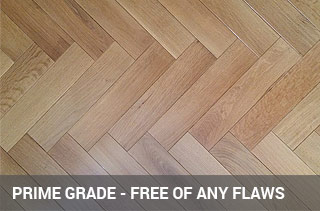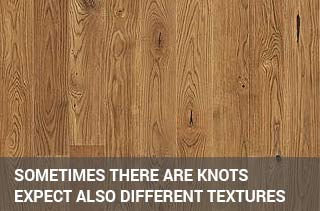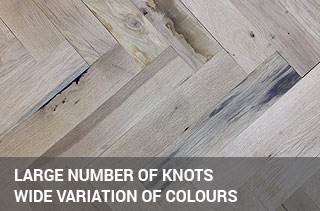Back to Flooring Products
Wood Flooring Grades Explained: Prime, Natural & Rustic
Wood is a natural material, and before it became the surface under your feet, it was part of a living, breathing tree. Just like no two people are alike, no two trees are identical either. This uniqueness is part of the beauty of real wood flooring, but it also introduces subtle (and sometimes not so subtle) differences in colour, grain, and texture. These variations affect not only the appearance of your floor but also its price.
To bring consistency and help buyers make informed decisions, a wood grading system was introduced. It categorises timber based on factors such as the amount of sapwood, colour variation, and the size and number of knots present. In the UK, the most common grading system for wood flooring uses three classifications: Prime, Natural, and Rustic.
Pro Tip: Wood grading doesn’t determine quality or durability—it’s purely about appearance and style. All grades can perform equally well; the right one for you depends on the look you want to achieve.
How to Avoid Confusion?
One of the challenges with wood flooring grades is that different countries and manufacturers often use different systems. For example, in China the system is divided into four grades rather than three:
- A – Perfectly uniform and carefully selected wood
- B – Timber with very small imperfections
- C – “Middle of the road” quality, with more visible variations
- D – Wood with a wide range of knots and colour differences
In the UK, the official system uses only three grades: Prime, Natural, and Rustic. However, things can get complicated because the UK imports wood from all over Europe—and beyond. When timber from countries like China enters the UK market, it doesn’t always neatly match the British classifications. To bridge this gap, some suppliers introduce additional terms such as “Select” or “Extra Rustic”.
This is why you might see the same type of wood described in slightly different ways depending on the supplier. For example, Prime is often referred to as AB grade, reflecting its consistent quality and minimal imperfections. These letters provide a way for suppliers to align international grading systems with the UK standard, ensuring buyers have a clearer picture of what they’re getting.
Quick Tip: Always ask your supplier to explain the grading system they use. This will help you avoid confusion and ensure you’re comparing like-for-like when shopping across different brands or countries.
It Is Up to the Manufacturer
 When it comes to wood flooring grades, it’s important to understand that each manufacturer may apply slightly different standards. What one supplier considers an A-grade material, another may classify as B. This lack of universal consistency is why knowing your supplier and their grading approach is essential before making a purchase.
When it comes to wood flooring grades, it’s important to understand that each manufacturer may apply slightly different standards. What one supplier considers an A-grade material, another may classify as B. This lack of universal consistency is why knowing your supplier and their grading approach is essential before making a purchase.
Take rustic wood, for example. Manufacturer X might define rustic (CD) grade as timber with knots no larger than 35 mm. Meanwhile, Manufacturer Y could allow significantly larger knots and still label it as rustic. The result? You might end up paying the same price for two products with very different appearances and qualities.
This variation highlights why it’s so important to compare not only the grade but also the manufacturer’s grading criteria. Without this awareness, buyers can easily be misled into thinking they are comparing like-for-like when in reality, the quality may differ significantly.
Pro Tip: Always request grading specifications or samples from your supplier. This way, you’ll know exactly what to expect in terms of knot size, colour variation, and overall appearance before committing to a purchase.
Prime Grade – The Best of the Best
 When it comes to wood flooring grades, Prime Grade sits at the very top. This is the most carefully selected timber, representing the highest quality and most uniform appearance. In theory, true Prime Grade flooring should be completely free of flaws—no knots, no sapwood, and minimal colour variation. It’s the cleanest and most consistent grade available, which is why it is sometimes referred to as “A” grade.
When it comes to wood flooring grades, Prime Grade sits at the very top. This is the most carefully selected timber, representing the highest quality and most uniform appearance. In theory, true Prime Grade flooring should be completely free of flaws—no knots, no sapwood, and minimal colour variation. It’s the cleanest and most consistent grade available, which is why it is sometimes referred to as “A” grade.
However, in practice, you may also see Prime flooring labelled as AB grade. This means the batch contains mostly flawless prime pieces, but with a few boards that may have very small knots or subtle imperfections. Even then, the overall look is one of elegance and refinement.
Prime Grade flooring is all about straight grain, smooth texture, and a highly uniform appearance. It is the go-to choice for contemporary interiors where a sleek, minimalistic look is desired. Of course, such precision in selection comes at a higher cost, but for many homeowners, the investment is worth it for the flawless aesthetic it delivers.
Quick Tip: Prime Grade wood flooring works especially well in modern apartments, luxury retail spaces, and elegant office interiors where uniformity and a clean finish are essential.
Natural Grade – The Perfect Middle
Natural Grade (sometimes labelled as ABC grade) strikes a balance between flawless uniformity and rustic character. With this grade, you can expect a mix of boards that include knots, variations in texture, grain patterns, and natural colour shifts. This creates a floor that feels more organic and true to the character of real wood, without being as busy or varied as Rustic Grade.
The quality within Natural Grade can vary significantly—some boards may lean closer to Prime (A), while others may resemble Rustic (C or even D). Despite this, manufacturers carefully select and blend the timber to ensure the overall appearance remains consistent and visually appealing. In many cases, coloured fillers are used to smooth out imperfections and make knots less noticeable, further enhancing the finish.
Natural Grade is often seen as the “best of both worlds” option. It provides enough character to showcase the wood’s authenticity while still maintaining balance and harmony in appearance. This makes it an extremely popular choice for both traditional and contemporary interiors.
Pro Tip: Choose Natural Grade if you want your floor to have authentic charm with some natural variation, but without the bold knots and contrasts of Rustic Grade.
Rustic Grade – The Best Wood Is Natural Wood
 Rustic Grade, also known as CD grade, embraces the full character of natural timber. This grade is defined by mineral streaks, numerous knots, sapwood, and wide variations in colour. Unlike Prime or Natural grades, Rustic flooring does not strive for uniformity—it highlights the true, authentic beauty of real wood.
Rustic Grade, also known as CD grade, embraces the full character of natural timber. This grade is defined by mineral streaks, numerous knots, sapwood, and wide variations in colour. Unlike Prime or Natural grades, Rustic flooring does not strive for uniformity—it highlights the true, authentic beauty of real wood.
Because Rustic floors are less carefully selected, they are typically more affordable than Prime or Natural grades. But affordability doesn’t mean compromise. In fact, many homeowners and designers choose Rustic for its unique charm. Every board tells a story, creating a floor with warmth, individuality, and character that can’t be replicated with synthetic materials.
The appeal of Rustic Grade lies in its honesty. These boards aren’t filtered to achieve a “perfect” look; instead, they showcase wood in its most authentic form. For some people, the natural imperfections may feel too busy, but for others, this variety is exactly what makes the floor special—bringing rustic charm and natural elegance into the home.
Quick Tip: Rustic Grade wood flooring is perfect for country homes, cottages, rustic interiors, or eclectic modern spaces where character and natural charm are more important than uniformity.
For a full overview of the services we offer across all types and grades of wooden flooring, visit our wood floor fitting services page.
Conclusion
Understanding wood flooring grades is essential when choosing the right floor for your home or business. Whether you prefer the flawless uniformity of Prime Grade, the balanced authenticity of Natural Grade, or the unique charm of Rustic Grade, each option offers its own appeal. Remember, grades don’t affect the structural quality of the wood—they simply reflect the appearance, character, and style of the boards. By knowing what each grade represents, you can make an informed decision that suits both your design preferences and budget.
At FlooringFirst!, we provide expert advice and professional wood floor installation to ensure you get the best results from your chosen grade. With the right product and professional fitting, your wooden floor will not only look stunning but also last for decades.
Quick Tip: Don’t choose a grade based on looks alone—always consider your interior style, maintenance preferences, and budget to find the perfect match.
Frequently Asked Questions About Wood Flooring Grades
Does the grade of wood flooring affect its quality?
No. The grade only refers to the appearance of the boards (colour, knots, sapwood, and grain). All grades are structurally sound and durable when manufactured to industry standards.
What is the difference between Prime, Natural, and Rustic grades?
Prime Grade has a uniform look with minimal imperfections. Natural Grade shows some variation, knots, and grain differences, offering a balanced appearance. Rustic Grade highlights wood’s full natural character with visible knots, colour variations, and mineral streaks.
Why do some suppliers use terms like “AB” or “Select”?
These terms are often used to align international grading systems with the UK standard. For example, Prime is usually AB. “Select” or “Extra Rustic” are marketing terms used by suppliers to describe boards that don’t fit neatly into the three UK categories.
Which grade of wood flooring is most expensive?
Prime Grade is usually the most expensive because it requires careful selection of boards with minimal flaws and a consistent appearance. Rustic Grade is generally the most affordable.
Which wood flooring grade is best for me?
It depends on your design style and budget. Choose Prime for modern, sleek interiors, Natural for a versatile balance, and Rustic if you love character and natural charm.
Need expert advice on selecting the right grade for your home or commercial space? Contact us today to discuss your project and explore our full range of wood floor fitting services.